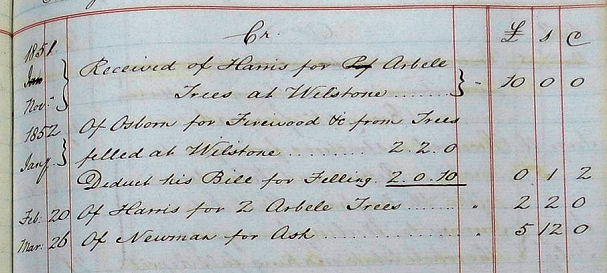While researching the photographer Thomas Latchmore I came across the following 1911 census transcription in which the first line looks decidedly odd.
So I looked at the image and found
It is clear that the first line of the transcription is totally wrong - apart from the surname not one field is correct. Like all commercial transcriptions speed of getting the product to market meant that accuracy suffered (to be fair FindMyPast is NOT the only culprit in this respect) but at least FindMyPast does have a means of correcting errors. So I reported the fault (reconstructed image)
Read on to find what happened
Friday, August 30, 2013
Old Hertfordshire Recipes - Brown Pea Soup
Brown Pea Soup
About 3 pounds of Beef, and half a pound of pickled Pork {Bacon makes it taste of smoke} a handful of white Pepper, 2 Onions, a pint and a half of split pease; six quarts of Water. Let them stew down 3 hours; put not any salt in until the last, and very little is wanted. Fry some Bread in Butter, then cut dices. Put it in your Tureen with a very little dried Mint. Some spinage boiled in Water by itself, put in the Tureen. You should put in two hearts of Celery at first with the Meat whole; and when it has boiled one hour & a half, or until it is tender, take it out and put it in the Tureen, after it is cut in thin slices. When the Soup is ready to serve up; strain it into the Tureen, and take particular care when it is strained, that there is not any Fat in it.
Wednesday, August 28, 2013
An Epitaph to Sir John Mandevile in St Albans Abbey
 |
| A typical 18th century gravestone |
One rich for nothing but a memory
His name was Sir John Mandevile content
Having seen much with a small continent
Towards which he travell'd ever since his birth
And at last pawn'd his Body for the earth
Which by a statute must in mortgage be
Till a Redeemer come to set it free.
Monday, August 26, 2013
What is an Arbele Tree?

When you are working with any old documents you will come across words whose meaning you don't know - and they may be archaic or dialect words. In looking at Folio 41 of William Brown's Account Book I found the above entry in the account for Joseph Grout of Tring Park.
The entry is clear. In 1851 Harris (possibly Joseph Harris, builder, of Berkhamsted) cut down a number of arbele trees, and a few months later cut down two more. While the exact location is not stated William Brown handled other transactions for Joseph Grout relating to a farm at Wilstone occupied by William Greening.
So what is an "arbele" tree. It is clearly not an Ash, which is mentioned on the same page, and an 1850 newspaper advert also rules out beech, elm, sycamore and fir. I turned to my collection of modern printed dictionaries and none of them included it. My Webster's Dictionary (1860 edition) does not have it - the nearest word being "arbalist" which was an old word for a cross-bow. Perhaps arbele wood was used to make the shaft of a cross-bow I thought - but I am sure Harris did not want to make crossbows. The original printed Oxford English Dictionary didn't have it either - but its coverage of agricultural and other technical terms has many missing words. However the online edition of the Oxford English Dictionary gives the following definition:
The white poplar tree, Populus alba. Formerly also the grey poplar, Populus X canescens (obs.)
This is where you must be careful not to jump to conclusions "just because the dictionary tells you." The quotations used to support this definition are in most cases unclear about which species of poplar tree is being mentioned. If we visit the area of William Greening's farm there are black poplars everywhere. They were obviously deliberately planted in the hedge rows (because there are only male trees they could not be self seeded) and the oldest trees might well be a couple of hundred years old. All the older ones have been pollarded. All the evidence suggests that they were considered as a commercial crop. There is one problem. They are black poplars, not white poplars.
See The Black Poplars of the Wilstone Area for the evidence for arbele being used to describe black poplars - at least in the Vale of Aylesbury area.
Please let me know if you find other places where the word has been used.
Sunday, August 25, 2013
Exploring the History of Hastoe House, near Tring.
 |
| The Account Book |
Folio 105 of William Brown's Account Book records that a Mrs Chesterman asked him to let Hastoe House and value some furniture.
Why?
William Brown also managed the property affairs for the Rev. James Williams, who lived in Tring Park. Folio 68 shows that in April 1852 the house was advertised to let. In May Mr Chesterman agreed to rent the house at £80 per year and on 16th of June Mr Chesterman brought the furniture in the house for £120. Ubfortunately he died on 1st July, 1852 - so clearly did not have much time to enjoy Hastoe House. William Brown's Account Book shows that the Chesterman executors continued to pay the rent until 1856 so I decided to see what happened to Mrs Hannah Chesterman - only to find that in 1853 she married William Brown's brother James!
I was hooked - and I decided to see what I could find out about the other tenants. This was made possible because all the 19th century editions of the Bucks Herald (published in nearby Aylesbury) are available on the British Newspaper Archive. A certain amount of intelligent deduction was needed - helped by the fact that Hastoe House was the only property in the Hastoe area which was posh enough to employ resident domestic servants.
The many tenants included Baron Rothschild in 1843 (he probably used it as a hunting lodge), the son in law of the Bishop of Chichester, a "retired squatter" (not what you might think), and William Brown's business partner. It seems that another tenant, a William Burns, died shortly after taking the tenancy. The only significant gap between 1841 and 1901 is that I was unable to discover the name of the tenant who was resident at the time of the 1861 census - as only their domestic staff are recorded.
It should be pointed out that it was possible to find so much out, comparatively quickly, because Hastoe House was the only "gentry" accommodation in Hastoe, which itself had a very small population.
Friday, August 23, 2013
John Amsden of Tring sells off some brewing equipment.
I have chosen a relatively simple entry as my first example of how useful William Brown's Account Book can be at highlighting an event in someone's life.
In December 1854 William Brown "received instructions to sell Brewery Plant &c by auction taking inventory and drawing catalogue" The goods sold for £11 15s but after paying for "printing & posting Bills and catalogues, advertisements & criers, &c." and commission so John Amsden only received £8 1s.
Read AMSDEN, Tring, circa 1854 to find out why John Amsden was selling up - and find out what he did afterwards.
John may have sold the beer he brewed from his house in Frogmore Street and one thing I failed to find out was whether there was a pub sign outside his house - and if so what was the pub called.
Tuesday, August 20, 2013
Family Legends are not always true! And I can't always help
 |
| Help Desk |
I occasionally get requests in which the correspondent quotes a family legend - but provides no supporting information - and in most cases I cannot take such requests further.
Nearly every family has some kind of legend - and when it is investigated it
turns out that it is only part true and has got modified over generations of
retelling. Many families have ancestors who fought at the battle of Waterloo - in some case
they did - and in other cases they were in the army at the time of the battle -
but were not involved in the actual battle. In the past there were big houses with many servants - and if your ancestor worked there as a housemaid the father of her child is (according to the legend) the son of the Lord whose house it was. Maybe it was - but the house probably employed a number of randy stable boys who were quite capable ... ... And if in doubt what makes the most memorable story?
One of my ancestors is described as being involved in an incident during the English Civil War - and research shows he was only three years old at the time. However the story may be true if the child involved was his older brother.
I can only look into such legends if (1) they relate to a clearly defined individual - and (2) you have already researched back to that individual. For instance if there is an illegitimacy I need to know as much as possible about what happened to the child (marriage, children, occupation if available, etc.) and why (if you don't have a baptism) you think they were illegitimate.
Saturday, August 17, 2013
Delays in responding to emails, etc.

At the beginning of my July Report I wrote
The original plan was that I took the month quietly but there were 29 posts and over 5900 visitor views on this newsletter, and over 22,000 to the main web site. The real problem was that I spent too much time on the site, and with holiday breaks, etc., other matters got neglected
A few days later, in discussing the future of the site I added
The "hidden" library in its widest sense (it includes quite a lot of non-genealogy material) occupies far too much of our house for comfort - is not cataloged - and the spare room is required for a visitor in a few weeks time!
OK - Our Australian visitor is soon to arrive, the spare bedroom is not yet ready, and over the last few weeks I have received far more emails and comments than usual, in addition to the daily pile of easily ignored circulars, etc. So far this month I have sent out over 30 emails (mainly in reply to ones I have received) and there are others still waiting for action in my inbox, in some cases from July.
I may have even less time to spend on the site, or replying to non-urgent emails, until our visitor leaves towards the end of September - and if there is a significant delay in responding to your post please accept my apology.
P.S. The comments "Cool", "Cool", "This is Great", Fantastic" and "Gorgeous" were posted on different posts on the newsletter by an undoubtedly criminal troll using the names "Celia", "Theron", "Chase", "Carrissa" and "Humberto". All were initially held until I checked them and have quite rightly been rejected as possibly dangerous spam, and reported to Google as such. The criminals who post such messages on hundreds (if not thousands) of blogs is hoping that someone will wonder who "Clarrissa" is and click on the name to see where the link takes them. If you click you could end up with something unpleasant - such as being infected with a virus.
Friday, August 16, 2013
The First Hertfordshire Photographers
 |
| Photographers |
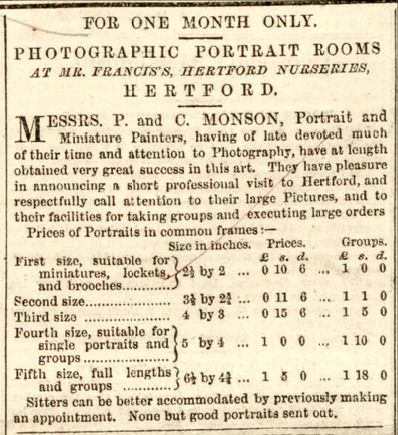 David Simkin, who runs the Sussex Photohistory web site kindly drew my attention to the fact that P & C Monson had been taking pictures in Hertford as early as 1853. I decided to follow this up by using the British Newspaper Archive, via FindMyPast, to see if I could reconstruct the early history of commercial photography in Hertfordshire, using references in the Herts Mercury and the Hertfordshire Guardian, both of which have been digitised for the relevant period.
David Simkin, who runs the Sussex Photohistory web site kindly drew my attention to the fact that P & C Monson had been taking pictures in Hertford as early as 1853. I decided to follow this up by using the British Newspaper Archive, via FindMyPast, to see if I could reconstruct the early history of commercial photography in Hertfordshire, using references in the Herts Mercury and the Hertfordshire Guardian, both of which have been digitised for the relevant period. |
| Newspapers |
It turns out that a photographer called Mr Williams had been at the Bull Inn, Hertford, in 1851. The first local photographist was a daguerreotypist called H F Cox in Fore Street in 1856 while Hart & Craddock were operating from North Crescent (later Arthur Elsden) in 1857. Charles Forscutt was operating at the Old Cross by 1859 and a plumber called John Charles Garrood started taking photographs in Ware Road, Hertford, in 1864.
I have also added many early photographic adverts to the Arthur Elsden page.
Thursday, August 15, 2013
Sir George Alexander at Chorleywood in 1911
 |
| Rickmansworth |
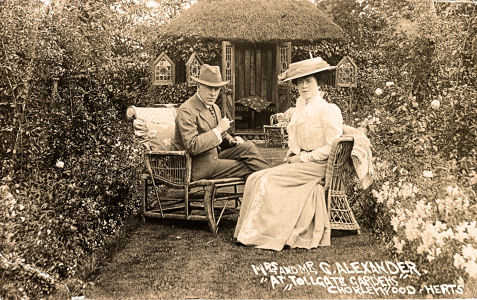 |
| Mrs & Mr George Alexander |
Following my recent posting of a picture of The "other" Oscar Wilde's currying connection with Hertfordshire I have now posted a picture of Sir George Alexander, the actor manager who lived at Chorleywood, Rickmansorth. He produced the "real" Oscar Wilde's plays Lady Windermere's Fan and The Importance of being Earnest. Sir George built Tollgate Cottage, Rickmansworth, not far from where the "other" Oscar Wild's family lived!
Wednesday, August 14, 2013
Project: William Brown's Account Book
 |
| Tring |
 The first of my priority projects to get underway (see Future of this Site - Thinking Ahead 2013-2018) concerns an old account book that had belonged to William Brown, estate agent, of Tring during the 1850s. I had purchased it on ebay with a view to passing it to the Tring Local History Society after I had properly indexed it, etc. About 4 years ago I had put some extracts from the book on this web site with a view to doing more - and the project stalled.
The first of my priority projects to get underway (see Future of this Site - Thinking Ahead 2013-2018) concerns an old account book that had belonged to William Brown, estate agent, of Tring during the 1850s. I had purchased it on ebay with a view to passing it to the Tring Local History Society after I had properly indexed it, etc. About 4 years ago I had put some extracts from the book on this web site with a view to doing more - and the project stalled.
The book provides a unique record of property related activities in and around Tring (in Buckinghamshire as well as Hertfordshire) especially as William Brown acted as land agent for the Rev. James Williams, who occupied Tring Park during the period covered by the book. It contains much of interest to local and family historians and needs to be readily accessible. The project involves making it generally accessible, and the following stages are planned.
 |
| Brown's Account Book |
- To get all 283 folios and the original manuscript index online and accessible. This stage has now been completed, and may be accessed at www.hertfordshire-genealogy.co.uk/links/tring-brown.htm
- Draw up a calendar of the folios which records the subject of each folio, including key place and personal manes. A draft listing identifying each folio with the folio title has been completed - but the additional text has only been done for the first 20 folios. The aim is to do a bit each week and complete by the end of the year.
- Complete a page contains a biography of William Brown.
- Produce about 25 detailed reports relating to the information contained - to act as a demonstration of the kinds of information in the document and how it can be used. Three are currently in draft stage and will be announced over the next two or three weeks. The aim is to produce one or two such reports a month. In addition I hope to encourage others to "adopt" a folio and produce further reports.
- Produce a talk on the document - and probably two or three articles.
- Find a home for the original document. As it has been digitised I no longer need the original to complete the project.
A progress report will be included in each month-end report.
You are invited to explore the page of the account book and let me have your comments.
A List of Later Project Reports
Tuesday, August 13, 2013
An update on the Rev Thomas Whitehouse of Baldock (and elsewhere)
 |
| Help Desk |
 |
| Baldock |
Gail has provided a correction to Thomas's marriage details and mentions that his son Cyril (who was born in Baldock) went to Malaysia. I have checked on Ancestry and it is possible that Cyril "run away to sea" at the age of 15. ... Anastasia provides more information on Cyril and I suggest the most likely death certificate for Thomas's wife Elizabeth Ann Whitehouse.
More.
Sunday, August 11, 2013
Heritage Open Days 12th-15th September
 |
| 12th-15th September 2013 |
Many organisations in Hertfordshire will be holding events, from conducted tours of old town centres to special exhibitions on historical topics. If you are associated with such events, and have finalised a programme relevant to this site, let me have details and I will mention it in this newsletter.
This Newsletter has now had 100,000 page views

The total was passed last night. Recently it has been hovering around 200 pageviews a day, and I will be interested to see if this holds up over the next couple of months when there will be extra demands on my time. We have our Australian visitor coming soon - till the end of September - and I have started downsizing by putting a pile of books for sale on ebay to help make space in the spare bed room! I also agreed on the phone last night to give a talk on "Some New Ideas on the Evolution of the Human Brain" early in September and need to prepare a Powerpoint style presentation and some notes. (Details of this talk will appear on my other blog Trapped by the Box.)
Saturday, August 10, 2013
How many pictures did an early Victorian photographer take in a year?
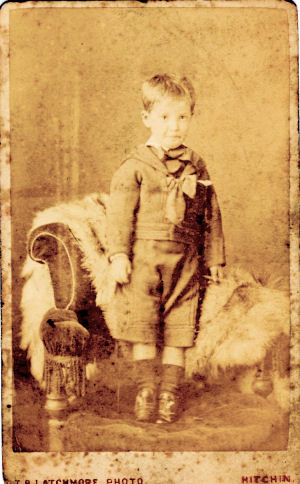
 |
| Help Desk |
Jackie has sent me a carte de visite she believed to be of John (Jack) Christy by T. B. Latchmore, of Hitchin. John was born in 1911 and the photograph shows John in short trousers and he is about 5 years old.
 |
| Hitchin |
Carte de visite were common in the 1860s, but started to be replaced by the larger cabinet cards in the 1870s - and were rapidly going out of fashion in the 1880s. It seems unlikely that this card, which otherwise looks like a typical Victorian carte de visite was produced in about 1916. It seems very likely that the picture was of John's father, Harry who was 4 years old, and living in Ashwell (near Hitchin) in 1881.
When one compares the negative number with other CDV by Thomas Latchmore it seems that he was taking about a thousand pictures a year. This should allow the approximate dating of numbered cards with no other date.
When one compares the negative number with other CDV by Thomas Latchmore it seems that he was taking about a thousand pictures a year. This should allow the approximate dating of numbered cards with no other date.
Coombrook House School, Hemel Hempstead
 |
| Help Desk |
 |
| Hemel Hempstead |
My mother went to Oakley Lodge School, run by Miss Emily Brocklehurst, in 1916, and by 1922 it had become Coombrook House School, and continued until about 1960. I have just had a query from someone who was there in the 1950s who wants to know more about the school at that time. As this site does not normally deal with matters less than about 100 years ago I was unable to help, beyond suggesting she tries to make contacts with other pupils through sites such as Friends Reunited and Our Dacorum (part of the Hertfordshire Memories network).
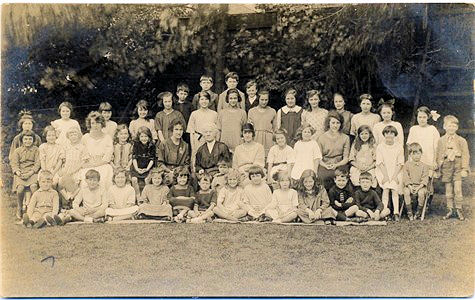 |
| Can you identify any of the pupils in this 1922 picture? |
I would be interested to hear from anyone who knows about the early days of the school - and if you can provide information on its final years I will certainly pass the information on.
Friday, August 9, 2013
Rural Relaxation - The Creation of College Lake Nature Reserve
My daughter Lucy's tragic death in 1985 had a major effect on my life, and was undoubtedly an important factor in my abandoning my research and taking early retirement. As a result I spent some 20 years on voluntary work to try and improve the lot of the mentally ill - and I urgently needed somewhere to relax
And I found just the place - a new reserve was being set up only a few miles from from where I live - called College Lake. When I first visited it there was a large white hole in the ground with the promise of a nature reserve at the south end - and a working chalk quarry at the north end. Graham was often seen with an enthusiastic team of volunteers, while Rita's little Sunday cafe in the old barn was not to be missed.
Over the years I have watched the quarry blossoming into a wonderful nature reserve. Under Graham's guidance the surrounding flat areas have grown up, and while the rising water drowned some of the lower parts plans were changed to make the best of the problem. First time visitors, looking out from the recently built Visitors Centre, find it difficult to imaging the natural looking marsh, swarming with wild life, is a recent human creation. And when I visit it on a weekday I am delighted to see classes of school children using the educational facilities and getting to know something about the countryside and what can be found there.
The Hertfordshire Great War web Site.
 |
| The Army in Hertfordshire |

I knew it was coming - but now the Hertfordshire Great War web site has arrived - at
http://www.hertsatwar.co.uk/.
I will be very busy over the next few months - so if you would like to write a review please tell me.
Thursday, August 8, 2013
Future of this web site – Thinking ahead 2013-2018

Over the summer I have been thinking about the future of this web site and I have come to the conclusion that I have been asking the wrong question. What I should really be thinking about is the future of my “history library”.
Think of the library as an iceberg where the web site is the small visible part at the top. Should the web site be closed to new material it could probably find a permanent place on the web, and can easily be copied onto a memory stick. The "hidden" library in its widest sense (it includes quite a lot of non-genealogy material) occupies far too much of our house for comfort - is not cataloged - and the spare room is required for a visitor in a few weeks time!
Tuesday, August 6, 2013
The "other" Oscar Wilde's currying connection with Hertfordshire.
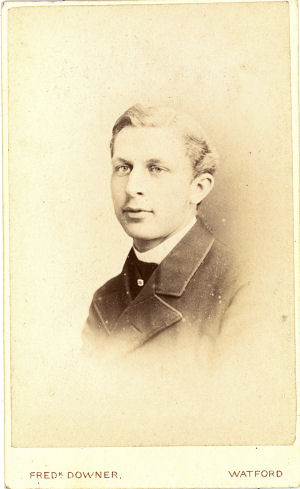 |
| Oscar W Wild in 1879 |
 |
| Help Desk |
Some time ago I acquired this carte de visite as an example or the portrait work of Frederick Downer of Watford. The back is labelled "Oscar W. Wild - Oct 26 1879" and I decided I ought to ask myself a question - Who is he?
 |
| Rickmansworth |
So I dug down into the census returns and other records and found he a member of the WILD family of Rickmansworth. His grandfather was Thomas Wild (1795-1871) who in 1851 was tanner at Mill End, Rickmansworth, employing 19 men, later becoming a farmer of 250 acres in the area.
Thomas had five sons. Two of his sons became significant tanners and curriers - Charles Wild (1820-1878) was employing 18 men and boys at Kingston on Thames in 1861 - but was buried at Rickmansworth. Alfred Wild (1821-1890) became a tanner, currier and shoemaker in the Windsor area - employing 51 men in 1851, later returning to Rickmansworth, where he died.. Another son Thomas Wild (1824-1887) was a master currier on a small scale in Watford High Street in 1861 and 1871.
Cornelius Wade Wild (1832-1917) and Edwards Wild (1835-1910) were significant farmers in the Rickmansworth area respectively running Shepperds Farm, Heronsgate (440 acres, 19 employees) and Stockers Farm, Batchworth (500 acres, 18 employees).
Oscar Wade Wild(e) (1858-1945) was the second son of Alfred Wild. He went to Oxford, where he added an "E" to become Oscar Wilde - a few year before the name became notorious because of the famous Oscar Wilde. He became a clergyman and was vicar of St Ives, Huntingdonshire from 1899-1930.
A Biography of Rev. Oscar Wade Wilde - A Wilde Goose Chase
Sunday, August 4, 2013
How do you spell Berkhamsted?
 |
| Census Returns |
 |
| Berkhamsted |
During most of the 19th century, and into the 20th century, there was no universally agreed way of spelling Berkhamsted - or Berkhampstead and other variations were not uncommon. For instance the official name for civil registration was Berkhampstead up to 1939 when it became Berkhamsted. The FindMyPast censuses names the town (when doing place name searches) as
Berkhamsted (1851, 1861, 1891, 1901)Berkhamstead (1851, 1871, 1901, 1911)Berkhampstead (1841, 1861, 1871, 1881, 1891, 1901, 1911)
These differences appear to have arisen because the people carrying out the census did not agree the name of the registration district they were recording! FindMyPast does not allow wild cards when searching for place names and this means that you will find no one living in Berkhampstead in 1851 - which was the official name of the registration district. In four census years a search for people living in Berkhampstead only some of the people living in the registration district will be found.
There seem to be similar problems with Ancestry but I did not carry out full checks.
I work on the basis that all online searches could be misleading and if I search for someone and do notget any responses I open up the search to, for example, see if there is anyone called John (any surname). If I still get nothing I try and find out whether there are relevant gaps or systematic errors in the data base - or the search routine is loosing the data,
Saturday, August 3, 2013
Finding the Ind Ancestors of an Baldock Brewer
 |
| Baldock |
 |
| Brewing |
Miriam was having difficulty in finding the parents of James Ind - the earliest "known" brewer in the history of the Ind Coope Brewery group. Prior to his marriage the surname Ind was effectively unknown in Hertfordshire and none of the contemporary records (which included a newspaper report of his death) gave any indication as to his likely date of birth. I therefore decided to closely consider the evidence available in the marriage register - which supported his social status - and included a witness, Robert Ind, that could well be his brother. Records in HALS and in early newspapers support the link between Robert and James, and provides an age at death for Robert.
 |
| Help Desk |
With this information family search came up with brothers James (baptised 1754) and Robert (baptised 1756), the children of Robert Ind and his wife Ann Ralph who married in Huntingdonshire in 1749. I also found another James Ind, a farmer in Fenstanton, Huntingdonshire, who might represent an earlier generation. As the Fenstanton farm included a maltings it is possible that the brewing history of the Ind family can be pushed back two further generations - but this will need more research in Huntingdonshire records to establish. For details of this wide-ranging research, which brings together information from many different sources, see IND, Baldock, 18th century.
Look out - There's a Husband About
 |
| A Karaktus Post Card |
Karaktus published some comic cards in St Albans in 1908/9 and as there is only a small number I am trying to identify all of them. I have just acquired a copy of No 7, and was amused by the message on the back. It was posted in February 1909 to a Mrs Gallop, of 4 Carlton Terrace, Hastings and reads:
I did not like to think you were disappointed so have sent this to show what will happen if I come to see you too often.Yours as ever, Bob
Thursday, August 1, 2013
Report on July activities -and some quickie reports
The original plan was that I took the month quietly but there were 29 posts and over 5900 visitor views on this newsletter, and over 22,000 to the main web site. The real problem was that I spent too much time on the site, and with holiday breaks, etc., other matters got neglected. In the next few days I will posting provisional plans for the future of the site.
Quickie Reports of Recent Correspondence and Updates.
Last year I was asked about the origins of an 18th century song which turned up in America and which had a specific reference to Barnet. Paul has written to say that when Thomas Marryat was in America between 1760 and 1766 he could not have met the Geyer family in Boston. I have contacted the original enquirer, Caroline, and reviewed what we know and where further evidence might turn up.
I have updated the contact information for people wanting to buy any of these publications.
Anthony Taylor has provided some additioina information
Audrey asked about the shop occupied by Joseph Austin (a butcher) in the 1851 census - and also about records of the location of contemporary graves in Berkhamsted. I am only able to give limited advice - can anyone else help her?
Anthony Carter pointed out that my original illustration was the wrong species - and I have replaced it with a more relevant picture.
Jon suggests that the badge could represent the letters SGC and wondered if this could be the uniform of people who worked for the St Albans Gas Company. Can anyone verify this - or come up with an alternative suggestion?
Brenda emailed me with some more information and I have added her note as a comment.
The latest edition of the Lost Cousins newsletter contains an article about the problems of searching for people with multiple given names which you might find interesting. Every online site has its searching idiosyncrasies and it is important to find out what they are. .
Subscribe to:
Posts (Atom)




